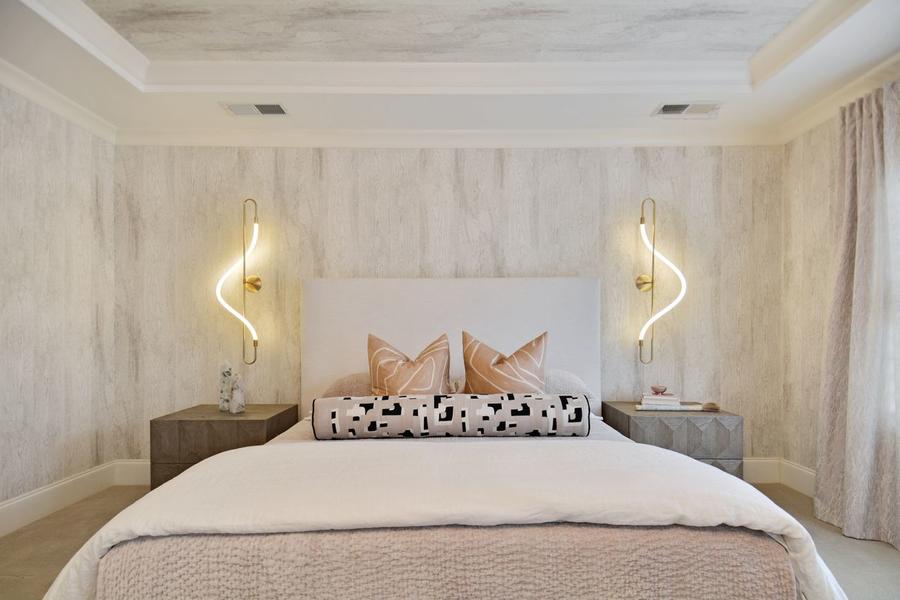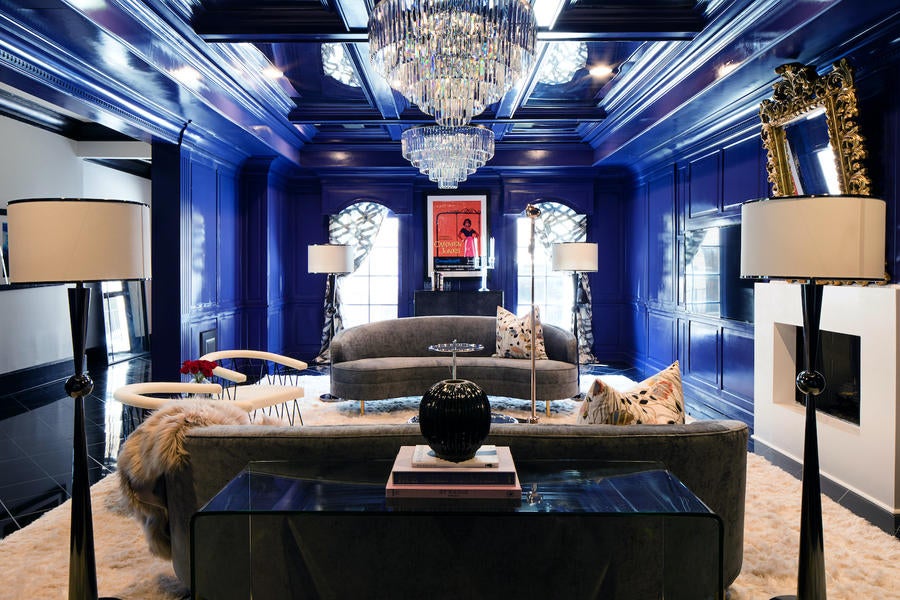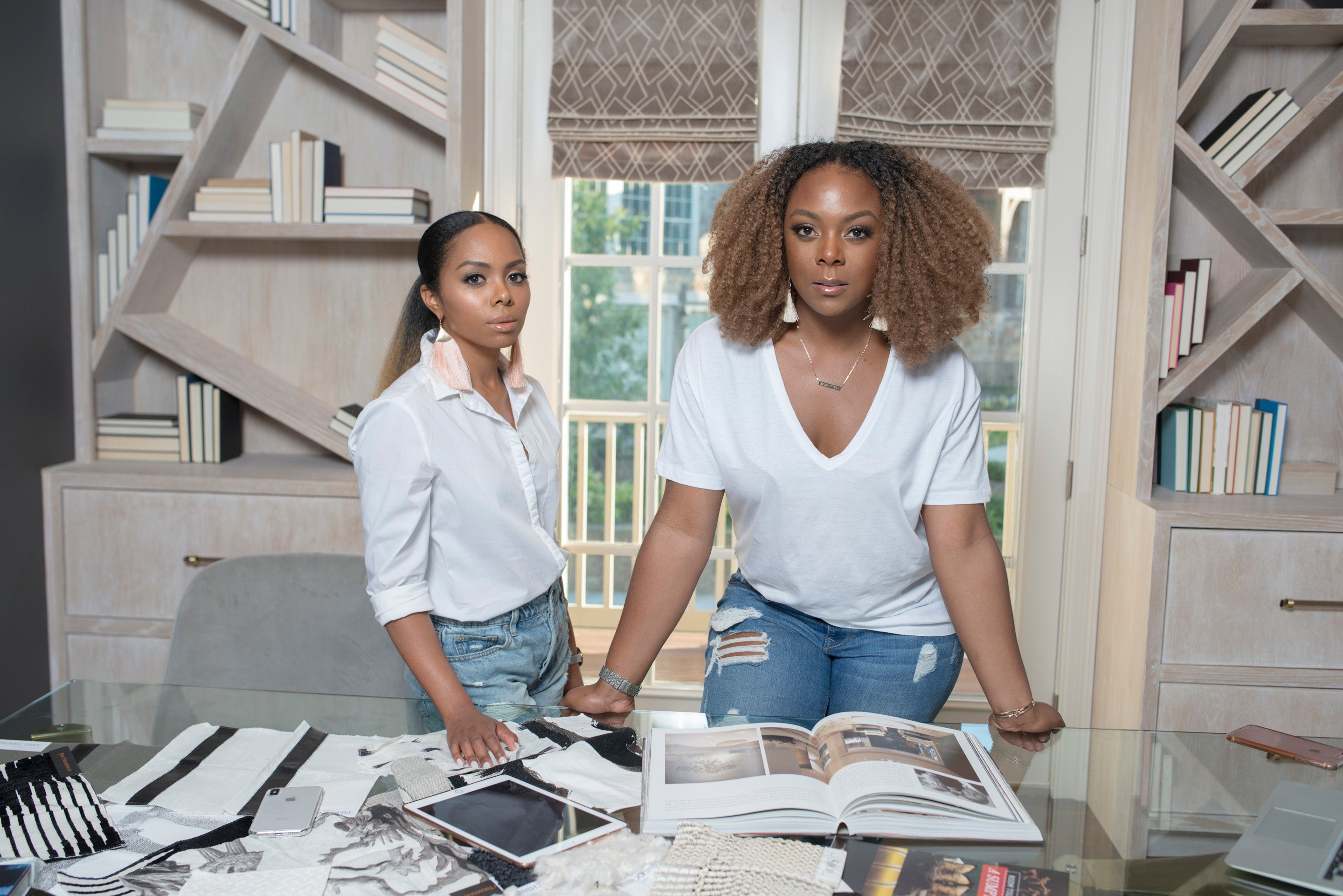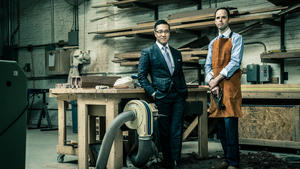The 50 States Project is a yearlong series of candid conversations with interior designers we admire, state by state. Today, we’re chatting with Tavia Forbes and Monet Masters, who founded their Atlanta-based firm Forbes + Masters in 2015 and spent the early years of their business as roommates. In addition to sharing favorite moments from their recent projects, they tell us about the origins of their unlikely partnership, how strong vendor relationships allowed them to complete their first showhouse without breaking the bank, and why they are reprioritizing midsize projects to grow their firm.
The two of you just got back from a work retreat. Why was it so important to get away?
Monet Masters: This was our very first retreat, but seeing what came from it, I think it’s important that we start having one or two a year. We talked about everything going right, everything that we want to change, and what type of goals we need to set.
Tavia Forbes: We also took the time to reconnect on a lot of things—looking back at how we started our business, how our business grew. We lived in different cities, then lived together and now are living separately. So we’ve had quite a few challenges and a very interesting partnership.
Masters: Starting our business as roommates and then separating into our own spaces affected the business a bit as far as our communication—and our personal connection too. We were able to see that and dive through it and find solutions. The retreat was one of those solutions, because now we’re talking about business and reconnecting our personalities, because that really does influence the workflow. It’s not just business, business, business. This is what we do to function and excel and make money, but part of all that is just getting along.
Rolling back the clock, when did you meet, and how did you start working together?
Masters: I was working on my first commercial project, [which was also] my first large project after I left corporate life. I designed the space to a T, but was not meeting the client’s expectations [with the execution]. It got to the point where it became toxic; tension grew because we weren’t making progress. They called in Tavia as reinforcement to help move the project along. At the time, I did not know what I know now, which is that Tavia was working heavily in Atlanta on commercial projects—specifically on salon designs, which is what we were focused on.
They called her in to mediate and said, “We’ll help you move your project along.” I was not as mature and focused as I am now, and I was offended. I did not want to work with anyone else. I didn’t want to have anything to do with the idea of assistance or someone else coming in. I did not have the right attitude in that meeting—which in turn caused me to get fired, and then they hired Tavia to complete the job.
Forbes: We actually met at a coffee shop. It was a very strange and uncomfortable meeting. We met for an hour or so about the project and how to move it along. Right after the meeting, the client left Monet and me to speak. So we had some time to get to know each other [and discuss] the design industry, especially being very young designers.
After that, I was called and told that Monet was let go from the job and they asked me to continue and finish the job. I was still very new and eager to get as much work as possible, so of course I took it. That evening, I got a call from a Houston number [where Monet is from]. I thought, “Oh. great. I’m about to get cursed out,” but it was not that at all. She was very kind and humble and like, “Let’s keep in touch and be friends.” We became work friends. We’d call each other and complain about all of the same things—about clients, about the nature of entrepreneurship.

You were both solo practitioners at that time?
Forbes: Yes. The resources that are [now] afforded to young designers of color in the design industry are very different than what was afforded to us at that time. So, a lot of [the job involved] relying on your friends for advice and immediate help on installs. We would essentially be each other’s assistants on projects.
We were always in conversation while I moved back to New York, [where I lived] and [would] fly to Atlanta for projects. When I got a call to do so-and-so executive’s office at a movie studio, and I wasn’t able to take the consultation because they wanted it done the following weekend, something told me to call Monet. She took the consultation for me and landed the job. I flew back that same night. We designed it, and in the process, we were like, “Well this is way easier.” We decided, “Oh, this could be a thing.”
What was it that was so much easier—having the creative feedback in that partnership?
Masters: Absolutely. I don’t know about Tavia, but this had been the first project where I had a client who was extremely creative—that was his title and career, to be creative. To have a client who tells you to “go crazy with ideas” allows you to explore different things that you hadn’t with previous clients.
It was an office, so function was absolutely the priority. But the energy of having someone else to bounce ideas off of, having a pretty decent budget, and then also having to do that very quickly—I deal very well in situations where I’m pressured or where there’s a quick turnaround. With all of those elements, I just really enjoyed it.
That was effectively the beginning of your business partnership?
Forbes: Yeah, I flew back to New York that week. Monet got a call to do a nursery the following week and was like, “Hey, do you want to come down and work on this together?” We didn’t formally form the partnership at that time, but we got through the projects in probably a fourth of the time we would have if we did it by ourselves, if you factor in second-guessing yourself, the physical design process and the execution.
How long ago was that?
Forbes: 2015.
Masters: At that time, we both were struggling a bit financially. It was like, “OK, let’s share these projects,” since we had been in communication about our businesses and talking every quarter about the stresses and struggles. After the nursery project, we were like, “OK, we have to come up with a name.” We were pushed into a speedier process in establishing the company with a name, a site, pictures and so forth.
Forbes: We quickly made it official and drew up a logo, had to establish the website, and then, of course, the legal portion of [co-founding a firm].
Masters: Your [company was called] Tavia Forbes LLC and my business was Masters of Design. The common theme was using our names, and we always get complimented on how strong our names are. So [we decided to] just stick with that.

Were you still in New York and Atlanta?
Forbes: Monet’s lease was coming up, and every time I would come to Atlanta to do a project, I was staying with her, so we were practically living together at that point. It just made more sense for me to live in Atlanta versus New York, because of how much business we were getting there. We had some different models in terms of client acquisitions. And by merging the two, we consistently stayed busy. Monet made sure our social media presence was great; Houzz and all of that was up. We essentially took projects that we both were proud of and used that to start our portfolio. And then most of my business was via referral. So, moving into clients that I’d already worked with and referrals from them.
Masters: I was like, “If this is what you’re paying in New York now, and this is what I was paying before getting a two-bedroom, we would basically be paying the same amount if we were to get this two-bedroom. That way, we could have a space here when you come up.” It just made sense. So, we got a two-bedroom and she came down.
Forbes: I was like, “Cool, love it. Let’s go.”
Masters: She told her boyfriend of, what, three years: “Hey, I’m moving to Atlanta.”
Forbes: Yeah, that was hard. We’re still together, if that helps!
So, you moved fully to Atlanta?
Forbes: Yeah, and it was abrupt. It was so abrupt, I’m not going to lie. I don’t think it sunk in [for my boyfriend] until I was like, “OK, can you send the rest of my stuff? My dad is going to drive it down.” He’s like, “Wait, what?”
How has your work evolved in the five years since you started the business?
Masters: It’s interesting you ask that question, because on the retreat, we were discussing clients, what they brought to the company financially, as well as how that affected our schedules, and inspired our projects versus where we want to go and where we are now. I think we’re going to start revisiting the types of projects that got us to where we are now and take those on a lot more, because they may not be [our] ideal [future] client, but they are the majority [of our revenue]. The majority [of our business comes from] those clients who have a budget that is probably around $10,000 to $15,000.
For a while, we were trying to step up from that, because we were also growing in our style of design, and wanted to start implementing those things, which we weren’t going to be able to fulfill with those budgets. Our style has evolved, but we are getting more focused on growing the business, staying busy.
When did you each know that you wanted to be a designer?
Forbes: I didn’t know being a designer was an actual career, but watching Trading Spaces on TLC, it was like, this is cool. I’ve always designed my family’s homes. My dad is a furniture maker. I went to school for business, not interior design. After college, I was doing event design, which I loved, because I loved doing floral arrangements and all of that, and merging the creativity of event design with the know-how of construction, being that my dad is a contractor and I have seen things being built.
I was doing the design for a wedding planner during the recession, so it was really hard to get a job. I was helping her, and then I met her publicist who walked up to me and said, “You did an amazing job. You’re designing my townhouse.” I was like, “Oh, great. I just quit my job, so this works.” That’s where the whole referral business started, and I haven’t stopped designing since.
Masters: I grew up in a lot of different homes. When I got to high school and was sitting in home economics class watching Trading Spaces, the thought came to me, Are these actors, or is this an actual profession? I started to pursue interior design on my own, as well as [explore] what college to attend. It wasn’t until I got to school [at Savannah College of Art and Design in Atlanta] and took classes about the psychology of interior design that I realized I could remember the look, the feel, the layout, the carpet color, the type of furniture in every home I have lived in, and that it was my love of design that caused me to always want to space-plan and change the furniture around in those houses—to fix pillows, clean and organize.

How many projects do you have right now, and how is your team set up to work on those?
Forbes: We’ve consistently taken on anywhere from seven to 15 projects at a time. But that can range from a whole house to one room or an office and so on. Right now we have a junior designer and a design assistant, still very new. We’re going to have the junior designer produce the design documents and presentation. The design assistant helps us with tasks for each project.
What we came to realize is that we were turning out projects very quickly with just the two of us. By adding that help to go through some of the mundane tasks, we can turn them over even faster, because that [covers] the vast majority of the inquiries we get, and it doesn’t make sense to dismiss that [smaller-scale] business. A higher-dollar project wasn’t necessarily going to stretch to fulfill the salaries for all four parties. We always do a pretty decent budget project, but those midlevel projects [are the most frequent ones], and are also creatively satisfying. We realized that we were not getting our hands dirty anymore—creating a fun wall or building something—and I missed it. We both spend a lot of time sketching and drawing patterns, and I like building things and missed being in the workshop to do that. We figured out a way to be financially and creatively satisfied in what brought us to design in the first place.
When did you make those hires and know those were the right roles?
Forbes: We had an install [coming up], so I went through our database and sent out an email to anyone who had ever been interested in interning with us. One woman answered the email—she was so helpful, offering suggestions when she felt it was appropriate in a humble manner. No matter the task, she was willing to help: unboxing something, putting tracks together, hanging a picture, making a bed, stuffing pillows. That hands-on style is exactly what we need, because we’re small and need leaders.
Masters: We get a lot of [potential job and intern candidates] emailing to say, “These are all of the ways I think you could help me, and all the ways this firm is perfect for me. You’re doing all these things and I want to learn them.” But the real question is: What are you doing for us? How are we benefiting? How are you going to assist? [People rarely] got that, whether it was on paper or in person on the job site. I remember someone showing up, and she stood there while Tavia and I had on masks and gloves scrubbing a screen. She was like, “Oh, that looks very difficult. Now tell me about what you guys are doing.” And we’re like, “Get out—or put on some gloves. But do something.”
After your first retreat, what are you most excited about?
Masters: For me, the biggest clarification is coming to terms with what makes us happy, what we each need to grow and function. I’m really excited to know that it’s a bigger deal for us to handle what’s coming to us, which are these medium-size projects—and to understand why we have to take them, too. It’s not just because it’s what we’re getting; it’s realizing that we’re going to stay in this area because we understand the fulfillment that we get from them at the end of the day.
Often, people get caught up in wanting to buy $10,000 sofas—to hurry up and get to this level of luxury interior design. But for us, that’s not entirely what’s coming to us, and we’re not able to get fulfillment from those projects [anyway]. So coming to terms with, “Yes, they’re not paying us to paint this wall, but we’re excited about it because they approved this awesome vision that we have and it’s going to be a portfolio project.” Getting back to that place of what we’re willing to do for projects and being able to decide if it’s a profitable portfolio project.
Is it readjusting what you say yes to?
Masters: Yes. It started off with [a conversation about], “Let’s not leave that money on the table [by turning away smaller jobs].” We were thinking about it as the business of design. There are multiple ways to make money, and there are different markets—the DIY market, the middle-income market, the high-end luxury market. We are paying attention to the inquiries we receive and [thinking about] how to not throw away good work. I think midlevel projects often get tossed away—or if they do get serviced, it’s not in a way that’s beneficial to the interior designer. But there’s a way to service [those clients] and not leave that money on the table—to work to our advantage, but also to the advantage of the client. We had to come up with a business model that would leave us financially happy, creatively fulfilled and with happy clients who then refer us.
I love what you said about how sometimes those midlevel projects aren’t great for the designer or for the client. What kind of changes can you make so that’s a better experience for everybody?
Masters: Manage their expectations. Interior design is a luxury service. I think explaining to the client what exactly they’re getting for that dollar amount—and it may not necessarily be white glove delivery. You may have to accept packages to your home. We typically send everything to a receiver, but that can be very costly. We [help the client] understand that would add about 20 percent to their project; to make a project come in [at a lower budget], maybe they’re responsible for those things. We will not sit with the painters, with the electrician and so on—those are things that you have to acknowledge [with the client].
I think our business is big on buying trade and providing clients with things they don’t see and probably will never see in their local stores and magazines. And with this clientele, giving them the expectation that yes, we’re going to be shopping from your local sellers, your West Elms and CB2. But hiring a professional service with skill, we’re still packaging that in a way that you couldn’t. We’re adding layers to that, so it’s a cross between DIY and luxury. They’re getting a little bit of both. They’re going to get that completed look, but it’s going to be pieces they’ve seen but never would have used.
Are there trade resources you find that cater to that clientele as well?
Forbes: As far as the price point, absolutely. The issue is often the receiving costs. I don’t really want to shout out Wayfair, but they actually have access to a lot of those trade vendors [through the online platform Perigold]. If you have a good rep, they can actually take care of the white glove delivery for you. If we bundle those orders, they can hold things for you and do the white glove service all at once. We also utilize trade programs from other retailers—West Elm, for sure, and Crate & Barrel, though it’s a little bit more complicated. They’re resources that you can use to fulfill that midmarket [client] with less headache.
How do you divide your time in finding resources at all of those price points?
Forbes: At High Point Market this fall, we got very organized. Instead of going to Market and collecting a bunch of brochures and having to sift through papers, we uploaded new vendors to our project management software, Trello. Every time we went to a different booth and found out their price point, we took a picture of their booth so we remembered visually what we were there for, wrote down their contact information, took a picture of the card for us to follow up or for them to follow up with us. We walked out of High Point without a piece of paper and a ton of resources.
You were part of the most recent House Beautiful Whole Home project. What was that experience like?
Masters: I think one of the things that did for us was help us to understand how important it is to have a good relationship with the vendors you do business with. It’s not just a single transaction—you're constantly building a relationship. One of the things that designers complain about when doing a showhouse is all the time and money they have to spend up front. Our room retailed for well over $150,000, but we were able to complete it for less than $10,000 out-of-pocket. We were very fortunate that for our first showhouse, our vendors were able to follow us there and help us.
What do you each see as your biggest business challenge right now?
Forbes: I would say the biggest challenge is scaling: how to scale your business outside of yourself and your personality. A lot of design has to do with a client buying the vision of another person. So turning that vision into a company—the idea that a client is buying a company now—is difficult. Definitely doable, but difficult. I would say that’s one of the bigger challenges for me.
Masters: The challenge is growth. It’s easy to interview the person for the position so that you can take off one of your hats. But you also have to have the time and the support system for that person to do their job; you have to have the money to pay them; and you have to basically force a relationship that should be natural [in a short amount of time]. When you meet a new friend, you naturally bond over time. But when you hire someone in a small business, you really have to develop that relationship quickly on so many levels.

What are you most excited about in 2020 and beyond? Where do you see the firm in another five years?
Masters: I’m the most excited about having an office space, which we are in the process of building now. It’s going to be in a new arts district that’s under development in East Atlanta. It’ll be fun to be around a bunch of creative artists of different types—there may not be other interior designers around us, but [there will be] artists and sculptors and all that. In five years, I see the company having products—and at least doubling our size in staff.
Where have you been working?
Masters: We’ve been working from home in Atlanta. We have a lot of coworking spaces in our community. We have a conference room, so most of our meetings and design presentations happen there, but the issue is having a place to have a library or being able to pull fabric very quickly. There’s always stuff in boxes between both of our homes, but [we want to] have a go-to place to pull out our books—and be able to pull it all, leave it out, and then revisit it with fresh eyes. We’ve realized that having to pack everything back up has been an interruption in the creative process.
How have you built your social presence over time? What has been the driving priorities as you’re thinking about social and online?
Masters: It goes back to what Tavia said at the top of our conversation: We’ve learned that we need to accept each other’s strengths and weaknesses, and how to blend both of our [business] models together. In the beginning, we were basically just [thinking], Now instead of one, we have two. But then I remember our mentor sitting us down for five hours, [telling us], “You are weak in this area. This is where you need to step up, but this is where you’re strong.” And it was the exact opposite for Tavia and me in every department.
When we talk about visibility for the company—when I was solo, I got projects and developed my company by being part of every group, having a profile on every site. I was actively networking and talking to vendors. Tavia put that same energy into the people she met, and her clients just kept referring her to more people. When talking about one of my largest parts of our business together, social media is kind of my department. I make sure that we are visible. I’m posting daily and staying in the faces of those who choose to follow us.
Forbes: I drink wine with clients. That’s my business.
The people part of it—nurturing people—is a big part too.
Forbes: You’re in these people’s homes and you become an extension of their family. When you spend enough time there, you know their homes better than they do. We’ve had clients get locked out of their home and text me, “Tavia, do you still have my key?” This is years after the project has ended—and I’ll be like, “I’ll be at the house to let you in.” I went to give her back the key and I was like, “Actually, it’s safer with me than you. I’ll keep it. Let me know if you get locked out again.”
You learn so much about your clients that they come to rely on you—Corey Damen Jenkins always says you’re the governor of their lifestyle. And you really are. We become family, and your network essentially just keeps growing because of that. More than likely, you’ll get a client that’s recommended by another client.
Masters: It’s all about managing expectations—and building as many relationships as you can along the way with those vendors, clients and other designers. I think nowadays, other designers are learning to lean on each other for advice. No one has ever talked about pricing, how they charge, or what they charge as openly as they do now. We’re all on the same page here, and we’re finding out that most people have the same struggles.
To learn more about Forbes + Masters, visit their website or find them on Instagram.
Homepage photo, from left: Tavia Forbes and Monet Masters. Courtesy of Forbes + Masters




























